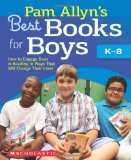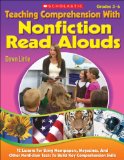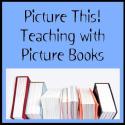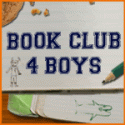The media has a lot to say about boys and reading. I will speak to recent media coverage over the next month. However, having been a teacher of fourth and fifth grade boys and now a mother of a second grade boy, I am always looking for ways to engage boys in reading. So this month on Literacy Toolbox, I hope to focus on boys and reading.
I begin with this post I wrote over a year ago as a guest on The Children’s Book Review:
There has been a lot of talk lately (well, several years lately) about boys and reading. Why don’t boys like to read? What can we do to encourage them to read? What is the difference in learning for boys and girls? As an educator and a mom of a six year old boy, I am intrigued by this “new” phenomenon. I am a reader. I do not know a life without reading. I hope that my children will become avid readers, too. But, I worry about my son. I know the statistics. Even though boys are pretty much developmentally even with girls when they start school, by fourth grade an average boy can be up to two years behind. How is that possible? What can we do to ensure that our boys don’t stray from the path of reading?
What Does the Research Say?
Boys are active beings. They have “boy energy.” They have a need to be physical, in motion, and kinesthetic (Gurian, 2005). . . pretty much all the time! They want to have fun! Instead of looking at these qualities as detriments, why don’t we use them to help our boys? Instead of teaching boys the way society dictates we should, perhaps we should start thinking about how boys learn best. If we begin to provide strategies that encourage boys’ interest in reading, we may begin to increase the possibilities for boys to experience success in school and beyond (Neu and Weinfeld, 2007). More importantly, we may encourage a lifelong love of reading in our boys, and isn’t that what we all want?
How Do We Make Reading “Boy-Friendly?”
The educator in me knew from the moment I had my son that I would have to work hard to raise a boy that enjoyed school and reading in particular. Through five years of teaching, I can probably count on one hand the number of boys that I taught that actually enjoyed reading when they arrived in my class. If we can work on making reading a more “boy-friendly” activity, we may be able to encourage more boys to read and to want to read. If we can attend to boys’ needs more when we read, perhaps we can encourage more boys to want to read and to enjoy reading! Here is a list of ten tips to help make reading more “boy-friendly” in your home or classroom:
1. Make Reading Active
Boys thrive on activity. Provide opportunities for boys to “act out” what they have read. For younger children, after reading a book, create puppets and put on a puppet show. For older boys, create a Readers Theater script. Have boys act out parts of the book.
2. Provide plenty of informational/nonfiction texts
Choose books based on interests. (See #8) If a child is going through a truck phase, borrow books from the library about different kinds of trucks. Provide boys with nonfiction subscription magazines. There are some great ones out there: Animal Baby (National Wildlife Federation), National Geographic for Little Kids, Sports Illustrated for Kids, Ranger Rick, National Geographic for Kids.
3. Provide Male Reading Role Models
This is probably one of the most important tips! My husband, a self-proclaimed non-reader, reads to our son every night and has done so since he was about a year old. They enjoy their time together and this gives them the opportunity to read gross, silly, fun books that I might not necessarily read with my son (see #10). Equally important is for boys to see men in their lives reading themselves. My son mostly sees his father reading news on the computer, but that is still reading (see #6)!
4. Graphic Novels are Boy Friendly
Boys tend to be visual learners. Therefore, graphic novels/books are excellent for boys. These are typically books that have been written in comic book form, but are not comic books (like your traditional Marvel comics). My son has a graphic book of The Lion King. It is probably at a reading level of a third grader, but we enjoy reading it together and looking at the pictures. I recently found Phonic Comics by Innovative Kids. They are written on various levels for your emergent reader all the way to your independent reader. More publishers are beginning to see the need for graphic novels and are translating known stories into graphic novels for all levels of readers.
5. Make Literacy Hands-On
For the preschool age child, put pudding on a cookie sheet and allow him to practice writing his name in the pudding. This is a great pre-literacy activity. For older boys, allow them to practice writing their spelling words in pudding. When they are done, they can eat the pudding!
6. Incorporate Technology into Reading
According to Neu and Weinfeld (2007), there is not necessarily a greater value in reading a book than in reading online. Boys tend to gravitate to the computer and the Internet can be a great source of informational text for boys. If a child wants to know the answer to a particular question, use a book and the Internet to find answers. This provides lessons in reading multiple sources, as well. Encourage older boys to use publishing programs to create visual representations of the text (See #4). This provides boys with an opportunity to process their reading.
7. Create Competitions
Challenge boys to informal spelling bees, brainteasers, or studying competitions. Boys thrive on challenges and competition can be the stimulant they need to really care about reading (Gurian, 2005).
8. Match Books to Interests/Allow Choice
One of the most important things we can do for boys is to allow them to choose their own reading materials. Even if the material is above or below their reading level, if it is a text on a topic that interests them, allow them to read it. A book that is “too easy” may allow him to feel good about reading; a book that is “too hard” may allow him to stretch his reading skills. By allowing boys choice, we are providing opportunities for them to develop reading skills without the added stress of disliking the text.
9. Encourage Audio Reading
Make recordings of yourself, or a male role model reading your child’s favorite books (or buy commercial books on CD). When you are unavailable to read to him, have him listen to the recording and follow along. Hearing books read aloud is a powerful way to increase boys’ interest in reading.
10. Encourage Reading of Humorous, Gross, Violent and/or Silly Books
Oh boy! This is a big one! If it grosses out mom, then a boy will probably find it engrossing. And that is the goal when getting boys to read. We want them engrossed in whatever it is that they are reading. If it takes a gross, humorous, silly, and/or violent (within reason) text to do it, then so be it!
A Few “Boy-Friendly” Books My Son Would Recommend:
The Trucktown Series by Jon Scieszka
Welcome to Trucktown! (Jon Scieszka’s Trucktown)
Trucktown came about as a series of books for preschoolers (girls like them just as much as boys!). Scieszka actually researched at a preschool near his house and has stated that all of the characters (which are all vehicles) are based on the preschoolers he worked with.
 Fly Guy (a series of books) by Tedd Arnold
Fly Guy (a series of books) by Tedd Arnold
Buzz Boy And Fly Guy (the most recent book in the series)
(the most recent book in the series)
A great series of books about a boy and his pet fly. Since one of the main characters is a fly, you can only imagine the gross things you may encounter when reading. However, the author writes humorously, as well. I enjoy reading these books with my son – not so gross, that I’m grossed out! My son and I recently read Buzz Boy And Fly Guy together and “we-viewed” it for “We-View” Wednesday. Check it out to see what my son thought.
together and “we-viewed” it for “We-View” Wednesday. Check it out to see what my son thought.
Chicken Butt! by Erica S. Perl
by Erica S. Perl
This is an example of buying against type. Not typically a book that would catch my eye for my own pleasure reading, but the title did catch my eye for my son. And, of course he loves it! So does my husband. It’s based on the classic joke, “You know what?”
 Smelly Locker: Silly Dilly School Songs
Smelly Locker: Silly Dilly School Songs by Alan Katz
by Alan Katz
We came across this book in the bookstore one day. My husband and son were looking for something to read together while I perused the shelves. Written about school life, each new song can be sung to the tune of a classic children’s song.
So, what are your thoughts when it comes to making reading “boy friendly?” Does your son like a particular book or series? Do you notice a difference between boys and girls, when it comes to book choices?
References:
Gurian, M. & Smith, K. (2005). The Minds of Boys: Saving Our Sons from Falling Behind in School and Life. Jossey-Bass: San Francisco
Neu, T.W. &Weinfeld, R. (2007). Helping Boys Succeed in School. Prufrock Press: Waco.
©2010 by Dawn Little for Literacy Toolbox. All Rights Reserved. All Amazon links are affiliate links and may result in my receiving a small commission. This is at no additional cost to you.
(Scholastic 2011) and review it here.
 question at this point. How do we get boys to read as much as girls? Why is there a disparity between boys and girls in reading? In the second section, she provides the reader with 24 questions and answers related to reading and boys, such as: How can we make boys comfortable with reading? Does online reading count? How can I celebrate and affirm boys’ achievements in reading? Allyn ends with an extensive annotated list of books that boys may enjoy. She explains a coding system – labeling books with E-for Emergent Readers, D – for Developing Readers, and M – for Maturing Readers – that has more to do with a boy’s emotional development rather than his chronological age. Books are listed by genre – genres that boys typically like.
question at this point. How do we get boys to read as much as girls? Why is there a disparity between boys and girls in reading? In the second section, she provides the reader with 24 questions and answers related to reading and boys, such as: How can we make boys comfortable with reading? Does online reading count? How can I celebrate and affirm boys’ achievements in reading? Allyn ends with an extensive annotated list of books that boys may enjoy. She explains a coding system – labeling books with E-for Emergent Readers, D – for Developing Readers, and M – for Maturing Readers – that has more to do with a boy’s emotional development rather than his chronological age. Books are listed by genre – genres that boys typically like.!















